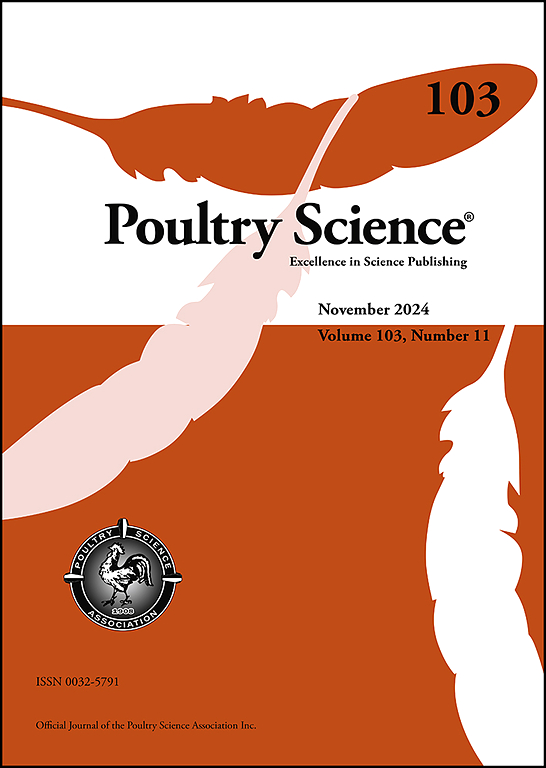Associating maternal keel fracture severities with egg quality, hen reproductive outcome, and chick welfare
IF 4.2
1区 农林科学
Q1 AGRICULTURE, DAIRY & ANIMAL SCIENCE
引用次数: 0
Abstract
Maternal conditions are known to affect offspring behavior and performance in laying hens. With evidence suggesting that keel fractures cause pain and may lead to stress and fear in affected hens, this study hypothesized decreased egg quality, reproductive outcomes, offspring chicks’ weight, and increased fear responses in the chicks as keel fracture severity increased.
120 Bovans brown layer breeders aged 61 weeks, with different keel fracture severities, were co-housed with 12 cocks at 20 hens+2 cocks/room. Eggs laid between weeks 65-70 were collected either for incubation or egg quality assessments. At week 70, 111 hens were euthanized, keel bones were dissected and scored (0:no fracture, n = 21; 1:slight fracture, n = 25; 2:moderate fracture, n = 29; 3:severe fracture, n = 36). Majority of the fractured hens (88 out of 90) presented hard callus without fracture gaps, suggesting healed fracture status. At hatch, 612 chicks were generated. Chicks’ body weight was measured weekly until week 5. All chicks were subjected to tonic immobility (week four) and novel arena tests (week five).
Dry shell weight was lower for moderate (P = 0.007) and severely (P < 0.001) fractured hens, while eggshell index was lower in severely fractured hens (P < 0.001) compared with those without fractures. Shell thickness decreased as fracture severity increased (P < 0.001). Overall, egg-breaking force was lower (P < 0.001) among fractured hens, but there was no difference in breaking force of the three fracture severity groups. Lower hatch rate was recorded in moderate (P = 0.038) and severely (P = 0.003) fractured hens compared with those without fractures. Irrespective of severity, chicks from fractured hens had lower odds (P < 0.05) of performing escape attempts, higher likelihoods (P < 0.001) of freezing and sitting inactive.
In summary, layer breeders with moderate and severe fractures, even after healing, produced eggs with lower shell quality, breaking strength, and hatch rate. At higher prevalence, this may have implications for the managerial practice and economic return of a breeder flock. Maternal keel fracture was associated with altered fear behavioral patterns in chicks, with a shift from active to passive responses.
母体龙骨骨折严重程度与鸡蛋质量、母鸡繁殖结局和雏鸡福利的关系。
众所周知,母性条件会影响蛋鸡后代的行为和性能。有证据表明,龙骨骨折会引起疼痛,并可能导致受影响母鸡的压力和恐惧,本研究假设随着龙骨骨折严重程度的增加,鸡蛋质量、繁殖结果、雏鸡体重下降,以及雏鸡的恐惧反应增加。试验选用61周龄的褐蛋鸡120只,龙骨骨折程度不同,配12只公鸡,20只鸡+2只鸡/房。收集第65-70周产的蛋进行孵育或蛋品质量评估。第70周,对111只母鸡实施安乐死,解剖龙骨并评分(0:无骨折,n = 21; 1:轻微骨折,n = 25; 2:中度骨折,n = 29; 3:严重骨折,n = 36)。大多数骨折母鸡(88 / 90)出现坚硬的骨痂,无骨折间隙,表明骨折状态已愈合。孵化时共孵出612只小鸡。每周测量雏鸡体重至第5周。所有雏鸡均进行强直静止(第4周)和新型竞技场试验(第5周)。中度和重度骨折鸡的干壳重较低(P = 0.007),重度骨折鸡的蛋壳指数较低(P < 0.001)。随着骨折严重程度的增加,外壳厚度降低(P < 0.001)。总体而言,骨折母鸡的破蛋力较低(P < 0.001),但三个骨折严重程度组的破蛋力没有差异。中度骨折母鸡(P = 0.038)和重度骨折母鸡(P = 0.003)的孵化率低于未骨折母鸡。无论严重程度如何,骨折母鸡的雏鸡尝试逃跑的几率较低(P < 0.05),而冻结和静坐不动的可能性较高(P < 0.001)。综上所述,中度和重度骨折的蛋鸡,即使在愈合后,所产蛋的蛋壳质量、断裂强度和孵化率都较低。在较高的流行率下,这可能对种鸡群的管理实践和经济回报产生影响。母体龙骨骨折与小鸡恐惧行为模式的改变有关,从主动反应转变为被动反应。
本文章由计算机程序翻译,如有差异,请以英文原文为准。
求助全文
约1分钟内获得全文
求助全文
来源期刊

Poultry Science
农林科学-奶制品与动物科学
CiteScore
7.60
自引率
15.90%
发文量
0
审稿时长
94 days
期刊介绍:
First self-published in 1921, Poultry Science is an internationally renowned monthly journal, known as the authoritative source for a broad range of poultry information and high-caliber research. The journal plays a pivotal role in the dissemination of preeminent poultry-related knowledge across all disciplines. As of January 2020, Poultry Science will become an Open Access journal with no subscription charges, meaning authors who publish here can make their research immediately, permanently, and freely accessible worldwide while retaining copyright to their work. Papers submitted for publication after October 1, 2019 will be published as Open Access papers.
An international journal, Poultry Science publishes original papers, research notes, symposium papers, and reviews of basic science as applied to poultry. This authoritative source of poultry information is consistently ranked by ISI Impact Factor as one of the top 10 agriculture, dairy and animal science journals to deliver high-caliber research. Currently it is the highest-ranked (by Impact Factor and Eigenfactor) journal dedicated to publishing poultry research. Subject areas include breeding, genetics, education, production, management, environment, health, behavior, welfare, immunology, molecular biology, metabolism, nutrition, physiology, reproduction, processing, and products.
 求助内容:
求助内容: 应助结果提醒方式:
应助结果提醒方式:


